|
Oplopanax horridus (Devil's Club)
|
Kingdom
|
: |
Plantae
– Plants
|
|
Subkingdom
|
: |
Tracheobionta – Vascular plants
|
|
Superdivision
|
: |
Spermatophyta – Seed plants
|
|
Division
|
: |
Magnoliophyta – Flowering plants
|
|
Class
|
: |
Magnoliopsida – Dicotyledons
|
|
Subclass
|
: |
Rosidae
|
|
Order
|
: |
Apiales
|
|
Family
|
: |
Araliaceae – Ginseng family
|
|
Genus
|
: |
Oplopanax
(Torr. & A. Gray) Miq. – oplopanax
|
|
Species
|
: |
Oplopanax horridus (Sm.) Miq. – devilsclub
|
|
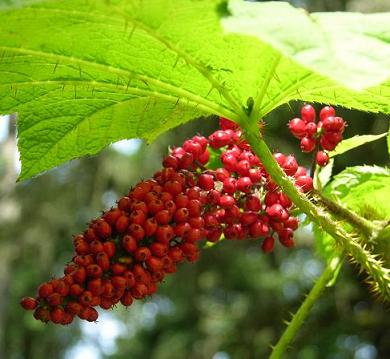 |
|
Note: Throughout
the years I've written short articles for our website's home pages
(home pages are the front page of a website) about these plants.
They are now included at the bottom of this page, and are
illustrated by botanical drawings and paintings, some of which are
from books published from 1500 - 1900. |
|
|
A truly unique addition to the garden, Devil's Club has
a tall, wand-like naked stem with vicious spines, topped with huge palmate
leaves surrounding the spike of tiny flowers. In
the summer, the flowers become a pyramid of brilliant, red berries.
This shrub grows from 3-9' tall and needs a moist and shady spot.
Closely related to ginseng, it has many medicinal properties and was one of the
most important medicinal plants for coastal Native Peoples.
Consider planting Devil's Club as a protector of rare specimens or along trails
to keep hikers from exploring: few will venture past the sharp thorns.
Native from Alaska to southern Oregon and east to the Great Lakes, this shrub is
hardy in USDA zones 4-9. |

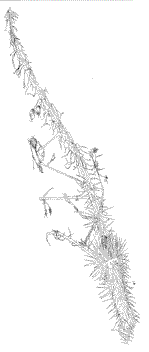
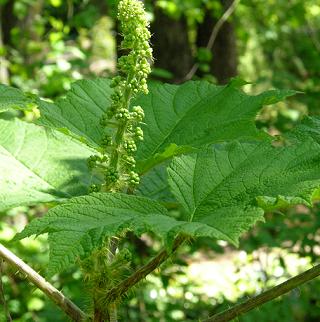 |
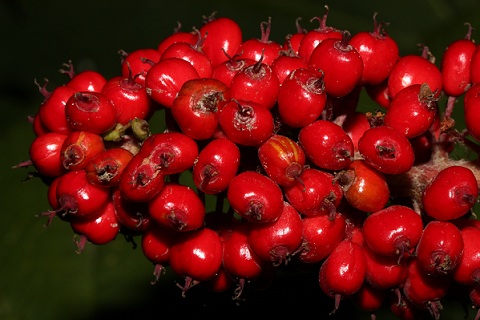 |
These two photos
(left and right)
were taken by
Walter
Siegmund |
 |
|
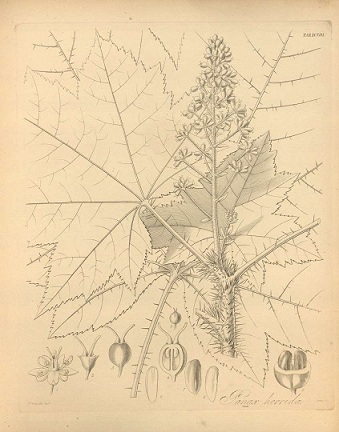 |
From Homepage July 5, 2003
What is that plant? Undoubtedly, that's the question most asked about
this week's feature plant, the Devil's Club (Oplopanax horridus). It's a
truly spectacular northwest native shrub, and Oregon's most unusual
botanical. Many folks have never seen or heard about our northwest
native Devil's Club. If you want an unusual shrub, this is the plant for
you.
The showy bunches of rich red berries clustered around the stems remind
one of the shape of spirea blooms. Ripening now, you must come out to
the nursery and see them in person.
Note the attractive shape of the twisted stems topped by large almost
tropical looking maple shaped leaves. Planted in groups, the incredibly
sharp thorns can make an excellent privacy screen or barrier against
unwanted visitors. Choose an area with semi- to full shade for your
Devil's Club. A woodland garden, a shrubby border, even containers are
suitable for this garden ornamental.
|
|
The thorns are needle sharp and scratches can become infected. Parts of
the plant are poisonous and parts were a principal medical source for
Original Peoples. The plant is in the ginseng family--famous for other
herbal remedies. Some commercial astringents, antiseptics, cough
mixtures and laxatives are processed from Devil's Club.
Though Oplopanax horridus is not often available for sale, check with
local nurseries if you are interested in adding this unusual plant to
your garden. |
|
From Homepage July 29, 2002
Oplopanax horridum (Devil's Club) is, to my mind, one of the most unique
and interesting northwest native shrubs. It is deciduous with a tall,
wand-like stem with sharp spines, topped with huge palmate leaves around
the flower. A shade and moisture lover, it is a wonderful choice for
landscape and one of my favorites because of the delightful shapes of
the stems.
|
 |
The
Devil's Club is quite an attractive and unusual shrub. Because of the
sharp "needles" along the stem, care should be taken when handling and
choosing a site in the landscape.
Native Americans have shown that Oplopanax horridum is useful for it's
medicinal qualities. The bark is shredded and made into tea, or oil is
extracted from the roots. It is used as an expectorant, reduces stress,
and increases one's sense of well-being. It is also used as a remedy for
certain types of diabetes.
Professor Suzanne Andersen Scotchmer of University of California,
Berkeley, wrote a delightful article called "Devil's Club Tea"
describing her introduction to Tlingit "medicine" by her friend
Clarence. Published in the Anchorage Daily News Sunday Magazine (We
Alaskans) on October 20, 1996 See
www.socrates.berkeley.edu/~scotch/alaska/devils.pdf.
An amusing story and very descriptive of Native American uses of this
native American shrub. |
|
|
|



